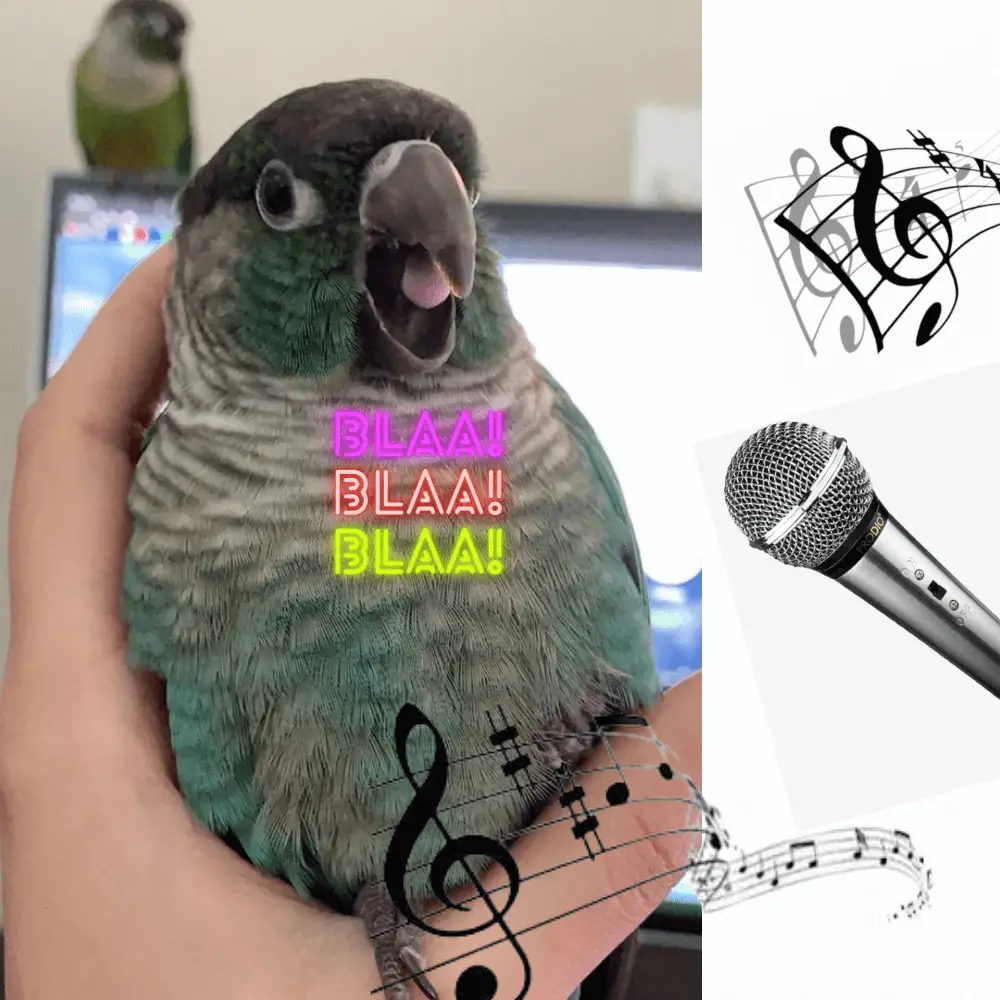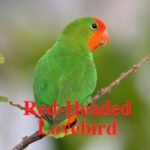
Green-cheeked conures are small parrots is native to Bolivia in South America. They are small birds with hymnic and clownish personalities to amuse everyone.
- Size: about 26 cm
- Weight: 2 to 3 ounces
- Lifespan: 20-30 years
- Phylogeny: Green-cheeked parrots belong to the family Psittacidae and subfamily Arinae. The genus Pyrrhura consists of long-tailed parrots from the new world of parrots.
- Gender Identification: Man and woman are visually identical (monomorphic). The DNA of the feathers can be used for identification.
- Common names: Yellow-sided conure or green-cheeked parakeet or green-cheeked conure or green-cheeked parrot.
- Scientific name (Species of the genus): Pyrrhura molinae
| Scientific classification | |
|---|---|
| Kingdom: | Animalia |
| Phylum: | Chordata |
| Class: | Aves |
| Order: | Psittaciformes |
| Family: | Psittacidae |
| Genus: | Pyrrhura |
| Species: |
P. molinae
|
Identification Guide
There are six subspecies of green-cheeked parakeets. Five of them are quite discernible and one is well marked (you can look at the photos above to see the differences).
1. P.m. molinae
- Crown at the neck: green tinged with brown
- Cheeks: bright green
- Hindneck: has some blue feathers
- Breast: pale brown barred with greyish white or dull yellow towards the center of the breast
- Feathers: tip, dark brown
- Eye ring: white
Geographical distribution: Eastern Bolivia
2. P.m. restricted
- Breast: brownish-gray crossed out with white
- Hindneck: has a blue-collar
- Cheeks: blue tinged with green
- Flanks and under tail covers: suffused blue
Geographical distribution: Santa Cruz, Bolivia
3. P.m. sordida
green morphology: similar to P.m. restricted:
- Breast: yellow suffocated center
- Flanks and under tail covers: little or no bluish suffusion
Yellow morphology, aka green cheek conure with yellow side:
- Throat: yellowish-white barred with brown
- Breast: upper breast yellowish-white barred with brown
- Underparts: yellow crossed out without distinction green and brown
- Covers below the tail: yellowish-white tinged with blue
Geographical distribution: southern Brazil and northwestern Paraguay
4. P.m. australis
- Globally: Paler than molinae
- Breast: yellow suffocated center
- Abdomen: a brownish-red spot
Geographical distribution: southern Bolivia and northwestern Argentina
5. P.m. flavoptera
Very similar to P.m. molinae but, here are some differences:
- Wing: The curvature of the wing and the edge of the carp are red-orange.
- Feathers: blue and yellowish-white mixed
Geographical distribution: northern Bolivia
6. P.m. phoenicia
- Tail: green towards the base
Geographical distribution: southern Brazil and north-eastern Bolivia
Do green cheek conures talk
As stated earlier, green-cheeked bullies are reputed to be a calmer species. Like other bulls, they can be noisy, but that’s not a problem yet. They have very low vocal potential, so if you expect to have a parrot that can speak, you may have a hard time training it.
Green Cheek Conure Talking & Sounds | Talking Parrot
SOURCE:PetsAndAnimals
Can Green-cheeked Conures Speak
Pineapple green cheeks can learn to mimic human speech, and pineapples can too. Pineapples don’t have the ability to make sounds that humans are capable of; therefore, they cannot speak in a way that we would understand.
Pineapples will use their voice for communication as well as for self-communication.
Say Hello To My New Friend Oscar The Pineapple Conure Parrot
SOURCE:PsychedelicBabe
Can pineapple green cheek conures talk
Pineapples can also sound an alarm call when in danger and will cry out to let their herd mates know they are being attacked by a predator such as a cat, dog, or human.
Pineapples can also squeal when handled or carried by a person, which is more common in pineapples that have been removed from the herd at a young age and raised as an individual.
Pineapple green cheeks will make kissing noises to show affection to their human companions; However, these pineapples can also scream when angry or scared.
Pineapples who haven’t had much social interaction with humans will scream more often because it’s the only way to get attention and show their displeasure over something.
Pineapple Conure Hazel’s says “stop it”
SOURCE:Peekaboo Parrots
Temperament and behavior
- Green-cheeked conures are smaller and generally quieter than conures of Aratinga species (such as January and Sun conures).
- It is an intelligent, curious, and interactive species.
- Green cheeks require regular interaction with their owners.
- They can be more active and social than cockatiels or parakeets, which can be both good and bad depending on the owner.
- They make one of the most cuddly parrots. If they are well trained, they can be considered shoulder birds.
- Green-cheeked conures hide under cage papers or the owner’s clothes.
- They can sometimes be destructive and have moderate bite potential. Since these traits are common to most big-billed parrots, green cheeks are no exception.
Care and exercise
- Green-cheeked bullies can live alone or in pairs, but they will appreciate being paired with other species of birds.
- Give your feathered companions clean, fresh air to breathe. Anything that emits heavy smoke or fumes, such as aerosol pesticides, paint, air fresheners, incense and burning plastics, is a potential danger to the bird.
- As with any other pet bird, regular baths are important for green-cheeked bullies. This will be a simple task for the owners. Some of them might even take a bath in a dish of water.
Cage and nest box
The best thing to do to take care of a bird is to keep it in a cage for as long as possible while protecting it from all kinds of dangers.
- A vertical cage that allows the bird to fly without obstacles is the most recommended. Horizontal cages are also suitable, but vertical cages are more likely to accommodate a green-cheeked parakeet.
- An ideal cage for a green-cheeked conure should be 18 to 22 inches wide and 36 inches high.
- The spacing of the bars should be 1/2 to 3/4 of an inch. It must be such that the bird cannot pass its head through the cage.
- The materials used for the construction of the cage must be non-toxic.
- A cage height that allows the parrot to perch at the level of the man’s chest or shoulders is the most comfortable.
- Under no circumstances should the bird be kept in a cage for more than 48 hours.
- A green-cheeked parrot may need a nest box throughout the year.
- The nest boxes should be vertical and measure about (10 inches x 10 inches x 10 inches).
Perches, playrooms, and toys
DIY perches or store-bought perches? Both are good, although good quality commercial perches are hard to find and quite expensive.
- The pole should be made of pesticide-free wood. It must be a safe chewable substrate. It is recommended to use natural branches with bark as a perch.
- The circumference of a perch wood should allow the bird to wrap its legs over most of the perimeter.
- The large pieces of fresh vegetables and fruit provided on a skewer encourage the search for food. You can get them at a pet store or at Amazon.
- Toys such as chewing items or foot toys, foraging toys are appreciated by green cheeky bullies. They like to be very active and if you can’t devote most of your time to them, you should definitely give them as many toys as possible.
Diet and nutrition
Green-cheeked parakeets food In the wild: small seeds of different plant species, Ambay pump wood trees and fig trees (Ficus calyptoceras) .
More than 50% of the bird’s diet should consist of formulated products, and the remaining portion may be human food with a mixture of good quality seeds and fresh food.
Feeding birds a diet rich in human food will result in a lack of many nutrients and may not provide certain nutrients such as vitamin D. A diet rich in seeds, on the other hand, can cause birds to consume excess fat.
Diets formulated in the form of granules contain the right balance of vitamins, minerals, proteins, carbohydrates, and fats. I recommend Zupreem natural pellets. It contains all the essential vitamins, minerals, and amino acids. The Green cheeks parrot will get used to it in a few days.
There are other granules like Roudybush, Hagen tropical, Caitec Ovenfresh bites, and Lafeber products that you can try. All of these products are pretty much the same in terms of the nutrients they provide.
Do not give food that is bitten by a human because human saliva contains bacteria that are not normal for parrots.
Flood Warning
A diet rich in human food can be considered only if it is developed with the help of a professional nutritionist.
Acceptable human foods
- Carrot
- Sweet corn
- Strawberry
- Spinach
- Capsicum (yellow, red)
- Beets
- Lettuce
- Green grapes
- Red raisins
- Cucumber
- Broccoli
- Cauliflower
- Pea
- Egg, baked chicken
- Macaroni, pasta
Health problems
There is no specific disease that manifests itself exceptionally in green-cheeked bullies. Common diseases include:
- Psittacosis, a bacterial disease
- Conure bleeding syndrome
- Avian bornavirus, a viral infection
- Blood Vessel Dilation Disease (PDD)
- Taste
- Psittacine beak and feather disease, a viral disease
- Marek’s disease virus
The cost of breeding a green-cheeked conure
According to the PETA Association, the general cost of caring for a small bird is 390 euros in the first year and 320 euros per year. My estimate is quite close to those numbers.
- Cage: €220-450
- Play in gyms, swings, and other toys: 100-300
- Food costs: 100-200 euros for food in the form of pellets
- Medical expenses: Although pet birds can hardly need a veterinarian, it is prudent to calculate medical expenses in advance.
How and where to adopt
Parrots are the last pets that should be adopted impulsively. They require long-term commitment as well as emotional and physical care. After a lot of research, if you commit to buying a green-cheeked conure, do not buy one in a pet store.
I highly recommend adopting one from a rescue center. This is the least you can do to prevent the illegal trade and cruel breeding of birds. You will provide a home to a bird in need.
You can adopt a green cheeked conure parrot in the following places:
- Saving a bird
- Adopt a pet
- Bird rescue centers near you
Similar species
Brown-bellied conures (Conure P. frontalis) are quite similar to green-cheeked conures. They differ from the latter by a green crown and an olive upper tail.
How I Taught My Green Cheek Conure to Talk
SOURCE:Pet Anything




















